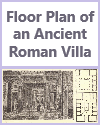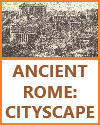Triumphal Arch of Emperor Constantine in Rome: Constantine was the first Roman emperor to convert to Christianity. Click here to enlarge. The Arch of Constantine is a well-preserved ancient Roman triumphal arch located in Rome, Italy. It is one of the most iconic and historically significant monuments in the city.
Architectural Features:
- Location: The Arch of Constantine is situated near the Colosseum, in the heart of Rome, making it a prominent landmark for tourists and historians.
- Architecture: The arch is made of white and gray Proconnesian marble and follows the standard design of Roman triumphal arches. It features three archways, with the central arch being the largest. Above the archways, there are decorative panels and inscriptions.
- Inscriptions: The arch is adorned with inscriptions that commemorate Emperor Constantine's victory over Maxentius at the Battle of Milvian Bridge in 312 C.E. The inscriptions also honor the Senate and People of Rome.
- Reliefs: The Arch of Constantine features decorative relief panels that were reused from earlier monuments, notably from the time of the emperors Trajan, Hadrian, and Marcus Aurelius. This recycling of artwork is significant as it reflects a practice of repurposing materials and art in ancient Rome.
Historical Significance:
- Celebration of Victory: The Arch of Constantine was built to celebrate Constantine's victory over Maxentius and his ascent to power. The Battle of Milvian Bridge is particularly notable because it was a pivotal moment in Roman history, marking the beginning of the transition from the pagan Roman Empire to one that was more accepting of Christianity.
- Religious Significance: Constantine's victory at the Battle of Milvian Bridge is often associated with his conversion to Christianity, or at least his tolerance of the Christian faith. This had a profound impact on the history of Christianity, as it led to the Edict of Milan in 313 C.E., which granted religious freedom to Christians and marked the beginning of Christianity's ascent to the status of a favored religion within the Roman Empire.
- Artistic Legacy: The Arch of Constantine is notable for its use of spolia, which refers to the reuse of earlier architectural and sculptural elements. This practice was not unusual in Roman architecture and art but is particularly evident in this arch. The reliefs from earlier monuments were incorporated into the arch's design, serving as both an homage to the past and a reflection of the practicality of the time.
The Arch of Constantine stands as a monument to an important moment in Roman history and the beginnings of Christianity's acceptance within the empire. It is an iconic symbol of both Rome's military triumphs and its evolving religious landscape.
|





















































